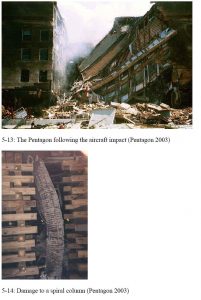The Pentagon terrorist attack of September 11, 2001, provides another case study of reinforced concrete building performance under extreme loading. The Pentagon performed quite well during the event, and as a result, the damage was localized to the area of immediate impact.
At 9:38 a.m. on September 11, 2001, a hijacked Boeing 757-200 airliner was deliberately crashed into the building. The impact hit the building about 43 m (140 ft) to the south of a boundary between the renovated section of the building and the next section scheduled for renovation. The aircraft continued into the section not yet renovated. The impact and fire killed the 64 people aboard the aircraft and 125 people in the building (Mlakar et al. 2003, p. 4).
Part of the building in the renovated section to the south of the expansion joint subsequently collapsed about 20 min after the aircraft struck the building. Photos taken between the aircraft impact and the collapse show that this portion of the building was sagging by about 0.45-0.6 m (1 1/2-2 ft). All five floors of the building collapsed. Some of the blast-resistant windows stayed in place even after the collapse. The collapse was confined to the outer E ring (Mlakar et al. 2003, pp. 17-26). Figure 5-13 shows the building after the collapse of the portion adjacent to the expansion joint.
The comprehensive work on the engineering aspects of the Pentagon on September 11, 2001, is The Pentagon Building Performance Report by the Pentagon Building Performance Study Team (Mlakar et al. 2003). The case is also featured in five papers published in the proceedings of ASCE’s Third Forensic Congress (Bosela et al. 2003).
Illustrations from Chapter 5 of the book Beyond Failure: Forensic Case Studies for Civil Engineers, Delatte, Norbert J., ASCE Press.






